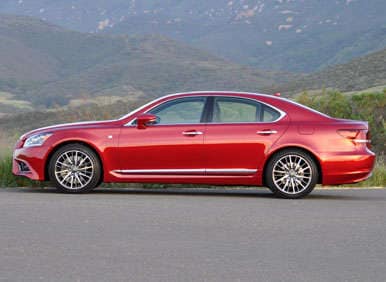Recent Articles
Popular Makes
Body Types
2013 Lexus LS Road Test and Review
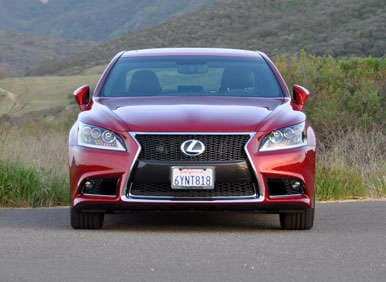
Twenty-three years ago, Lexus launched in the United States, the LS serving as the new luxury brand’s flagship sedan, the model parent company Toyota engineered in a bold play to give Lexus instant credibility as a top-tier maker of premium automobiles. Today, the 2013 Lexus LS continues in this role, competing in a rarefied stratum of the market against the Audi A8, BMW 7 Series, Mercedes S-Class, Porsche Panamera, and Hyundai Equus.
Yep. I went there. Here’s why.
The Lexus LS is uniquely positioned in the modern pantheon of full-size luxury sedans. The German brands against which it competes are more expensive than the Lexus when equivalently outfitted, especially the Mercedes, which starts a full $20,000 higher than the Lexus. The Korean Equus is more closely matched to the LS in terms of powertrain and equipment, but is clearly not up to par in many respects, an inferiority that is reflected in its lower price tag. Add a deserved reputation for dependability, not insignificant for vehicles with this much high-tech gadget-zootery, and the Lexus LS offers genuine left-brain appeal.
What’s been missing from the Lexus LS recipe since that first one rolled off the boat has been design and dynamics to excite the right side of a luxury sedan buyer’s brain. Lexus is determined to change that, and has given the 2013 Lexus LS a thorough mid-life update designed to inject some excitement into the lineup.
To find out if the LS still requires its Driver Attention Monitor with Closed Eye Detection system, I borrowed a 2013 LS 460 equipped with the new F Sport Package. Having now spent a week behind its wheel, I’ve gotta say I’m impressed. But the LS still disappoints in some ways.
2013 Lexus LS Road Test and Review: Models and Prices
Lexus offers the 2013 LS 460 in standard and extended wheelbase lengths, and with or without all-wheel drive. An ultra exclusive LS 600h L hybrid model is also available, only with the longer wheelbase, and only with AWD. Prices range from $72,885 (including the $895 destination fee) for the LS 460 without options to $134,860 for the LS 600h L with every factory option.
My test car was the LS 460 equipped with the F Sport Package ($8,350), F Sport Comfort Package ($1,650), Mark Levinson premium surround sound audio system ($1,580), LED headlights with intelligent high-beam control ($1,450), Blind Spot Monitor with Rear Cross Traffic Alert ($500), All-Weather Package ($200), a trunk mat ($105), and a cargo net ($64). The total tally came to $86,784.
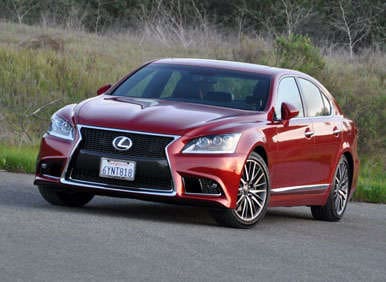
2013 Lexus LS Road Test and Review: Design
- Restyled exterior with new spindle grille design
- Increased structural rigidity improves ride and handling
- Redesigned interior offered in new Topaz Brown color
- New Shimamoku interior wood trim selection
- Advanced Illumination System with LED interior lighting
- Optional LED headlights
- Optional F Sport Package
Lexus is rallying its lineup around what it calls a new spindle grille design, which looks better on some of its cars and SUVs than it does on others. The aggressive look is entirely appropriate for the LS equipped with the F Sport Package, but might be too bold on what has been, traditionally, a conservative and stately automobile. In any case, it cannot be ignored, which is the automaker’s intent in the first place.
The spindle grille is the centerpiece of an exterior restyle that gives the LS a sharper look than before. The entire front end looks sculpted and powerful rather than amorphous and anonymous, while the rear end has a more tailored and aggressive look than before. Viewed in profile, the new LS looks much like the old one, fairly generic except for the jarring S-shaped seam where the wraparound taillights meet the rear bumper cover.
Add the F Sport Package to the Lexus LS, and the car gets unique front styling with a mesh grille and larger air intakes, round fog lights, and 19-inch forged aluminum BBS wheels with a dark finish and machined surfaces. Aluminum cabin trim is also included with the F Sport Package, along with a black Alcantara headliner and black leather sport-bolstered front seats.
Inside, Lexus designers have attempted to divide the dashboard into an upper Display Zone and a lower Operation Zone. That means the Optitron gauge cluster and the new 12.3-inch high-resolution LCD split-screen infotainment display are located, naturally, in the Display Zone while all of the car’s buttons and knobs are located in the Operation Zone. The zone approach is fine, except for the fact that some buttons in the Operation Zone are hard to see while driving.
What is hard to understand is why Lexus dips so frequently, and obviously, into the communal parts bin to outfit its flagship sedan. The parts it chooses to use are refined, but they look exactly like what one might find inside a Toyota. Take the power mirror switch, for example, or the cruise control stalk, or the turn signal stalk, or the wiper stalk. Plus, there are unnecessarily inexpensive bits and pieces, like the overhead grip hinge covers, the creaking plastic rearview mirror housing, and the flimsy-feeling cupholder cover. Brace your leg against the padded center console, and it creaks under the pressure.
Maybe you think I’m nitpicking. Perhaps you’re right. But when you’re talking about spending north of $70 grand on a new set of wheels, the details had better be right.
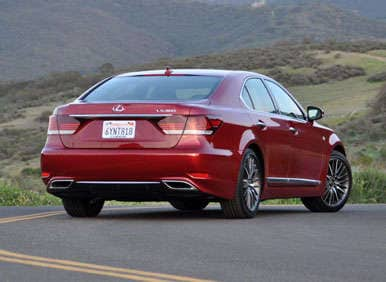
2013 Lexus LS Road Test and Review: Comfort and Cargo
- Additional sound insulation for a quieter cabin
- Redesigned front seats with improved heating and ventilation
- Optional Lexus Climate Concierge with power rear seats
- Optional F Sport front seats
For 2013, Lexus debuts its optional Climate Concierge system, which adds power-adjustable rear seats and a 4-zone climate control system that regulates cabin temperature in each zone as well as outboard climate controlled seats. The system also controls the heated steering wheel.
My test car did not have this feature. Nor was it equipped with the optional individual rear seating with a right-side ottoman and a Shiatsu massager. What it did have was the sport-bolstered front seats that are included with the F Sport package, wrapped in perforated leather. The driver’s seat is more comfortable than the front passenger’s seat, but only because it has a power thigh support extension that the other seat lacks.
Slip into the rear seat, and you might initially find it positioned too low and reclined too much. You get over that feeling rapidly, sinking into the plush yet supportive bench, enjoying significant legroom even in the standard-wheelbase model. Unfortunately, toe space under the front seats is nearly non-existent.
The LS 460’s doors shut with authority, and the cabin is impressively hushed when traveling at legal speeds. The finished trunk is large, measuring 18 cu.-ft., more than all competitors. Keep that in mind when you’re thinking about how many golf bags you’ll need to carry.
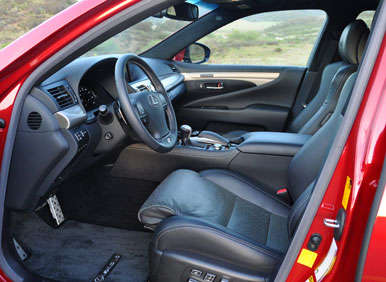
2013 Lexus LS Road Test and Review: Features and Controls
- 12.3-inch, high-resolution, split-screen infotainment display
- Next-generation Remote Touch controller
- Lexus Enform with App Suite technology
- Optional paddle shifters with F Sport Package
- Optional rear-seat entertainment system with Blu-ray DVD player
Every automaker is taking a unique approach to the development and design of infotainment interfaces, and with only a few exceptions, it is relatively easy to acclimate to a given system with time. The Lexus Remote Touch controller is no different, operating like a computer mouse with haptic feedback sensation to help guide the driver as he or she switches between looking ahead at traffic and looking at the information on the 12.3-inch screen.
Speaking of the driver and displays, the Lexus is equipped with beautifully rendered Optitron gauges, but there is no Thin Film Transistor (TFT) configurable instrumentation display option for this car, a feature rapidly becoming common. You can get one in a Dodge Dart, for example.
Not that people need additional distractions in their vehicles, but the LS is equipped with Lexus Enform telematics with App Suite technology. Pair a smartphone to the system, and you can search the Internet using Bing, stream Internet radio, or check-in on Facebook Places to make sure everyone knows where you are at all times. So desirable.
My Lexus LS 460 F Sport test car had carbon fiber-pattern aluminum dashboard trim, which looks sensational. But as I’ve mentioned, too many of the LS model’s switchgear reminds me of a mainstream Toyota, including the markings used to denote certain controls. I think it’s great that Lexus is making an effort to differentiate its cars with more aggressive exterior styling. Now its time to give them bespoke interior components.
On a positive note, the shared controls are simple to understand and easy to use. With a Lexus LS, there are no unmarked knobs, no touch panel buttons, no proximity-sensing screens. The result is less tidy to the eye, yes, but OMG I prefer the Lexus layout to, say, the exercise in obfuscation that is a modern Cadillac.
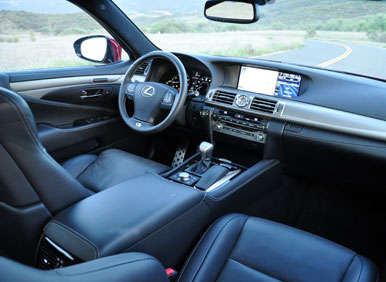
2013 Lexus LS Road Test and Review: Safety and Ratings
- Pre-Collision Safety with Collision Avoidance Assist
- Optional Blind Spot Monitor with Rear Cross Traffic Alert
- Upgraded optional Lane-Keep Assist system
The 2013 Lexus LS is offered with a long list of standard and optional safety features, including new Advanced Pre-Collision System. At speeds under 24 mph, this system identifies when a collision with another vehicle or a pedestrian is imminent, prepares the braking system for full braking power, retracts the car’s seatbelts and, if the driver takes no action, can bring the car to a full stop without driver intervention. At higher speeds, this technology alerts the driver to danger ahead to try and avoid a collision, or takes action to slow the car in order to mitigate the consequences of a collision.
New for the 2013 Lexus LS, the Blind Spot Monitor and Rear Cross Traffic Alert system identifies when traffic is in the car’s adjacent blind spots and when traffic is approaching the car from the side during a reversing maneuver. Lexus also says it has updated its Lane-Keep System, which alerts the driver to an unintended lane change and can take action to prevent the car from unintentionally drifting into an adjacent lane.
The only crash-test scores offered for the 2013 LS come from the Insurance Institute for Highway Safety (IIHS). The IIHS gives this large luxury sedan a “Good” rating in the moderate overlap frontal impact test and a “Good” rating in the rear-impact injury prevention test. The LS has not been tested by the IIHS for side-impact performance or roof crush strength, and the NHTSA has not performed any crash tests on this model.
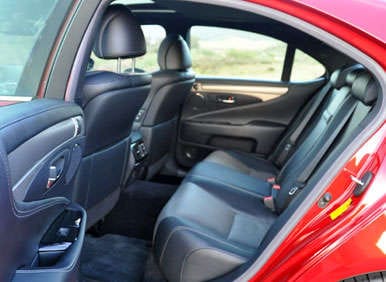
2013 Lexus LS Road Test and Review: Engines and Fuel Economy
- Drive Mode Select with Eco, Normal, and Sport driving modes
A 4.6-liter V-8 engine is installed in every LS 460 model, generating 386 horsepower at 6,400 rpm and 367 lb.-ft. of torque at 4,100 rpm. Choose AWD, and horsepower drops to 360 while torque falls to 347 lb.-ft. Lexus says the LS 460 accelerates to 60 mph in 5.4 seconds with rear-wheel drive, and 5.9 seconds with AWD.
The engine requires premium fuel, and is EPA-rated to get 16 mpg in the city, 24 mpg on the highway (23 with AWD), and 19 mpg in combined driving (18 with AWD). During my week with the LS 460 F Sport, I averaged exactly 19 mpg in a mix of driving, with the miles covered in a relatively even split between Normal and Sport driving modes.
The LS 600h L is equipped with a gas-electric hybrid powertrain that combines a 5.0-liter V-8 engine with two electric motors and a sealed nickel-metal hydride battery pack. A continuously variable transmission with Normal, Power, and Snow modes delivers the powertrain’s combined 389 horsepower to all four of the car’s wheels. Fuel economy ratings are 19 mpg in the city, 23 mpg on the highway, and 20 mpg in combined driving.
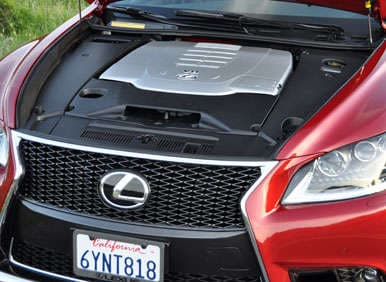
2013 Lexus LS Road Test and Review: Driving Impressions
For 2013, Lexus has made significant efforts to improve the way the LS drives and the transformation in the car’s driving dynamics, with the optional F Sport Package, is nothing short of miraculous.
All Lexus LS models receive standard frequency-dependent shock absorbers to better control body pitch and bounce, recalibrated brakes for better pedal feel and more immediate response, and upgraded steering for improved accuracy and faster turn-in. Additionally, models equipped with an air suspension add Comfort and Sport+ settings to the standard Drive Mode Select system.
Now add the F Sport Package to the equation, with its 19-inch forged aluminum wheels, stickier tires, limited-slip rear differential, lowered and sport-tuned air suspension, and bigger Brembo brakes with 6-piston calipers. I took my test car for a rousing run down Latigo Canyon Road in Malibu, Calif., a writhing compendium of narrow switchbacks and blind hairpin corners frequently peppered with pavement heaves and fallen rocks, and was frankly stunned by the LS 460 F Sport’s unfailing competence.
Drive Mode Select was set to Sport+ for this part of my test drive, which delivers the firmest suspension setting, the firmest steering calibration, and the most responsive powertrain characteristics. The car’s new paddle shifters came in handy for this drive, and the V-8 sounds great when revved high enough to penetrate the Lexus’s fortress of sound insulation materials.
Lest you think that Sport+ turns the LS 460 into a BMW M or Mercedes AMG competitor, it doesn’t. The suspension remains fairly absorbent; the steering is still slower than super-sedans from Europe. And without a more powerful engine under the hood, the LS F Sport isn’t any quicker than a standard-issue model. But these aren’t deal breakers. After all, the LS F Sport is about giving Lexus buyers an option with an extra injection of style and performance, not about wooing enthusiast loyalists from German brands.
Switch Drive Mode Select into its Comfort mode, or keep it in the Normal mode that is the default each time the car is started, and the LS F Sport exhibits all the lazy throttle response and waftability that has been a hallmark of the model for decades. Cruise down a freeway or a city street in this car, and it filters the outside world in a manner entirely befitting of a luxury sedan of this caliber.
The only significant irritant about driving the revamped LS pertains to the new brake pedal calibration, and I can only speak to my experience with the upgraded F Sport components. The brake pedal is hyper sensitive, and combined with safety features designed to think for the driver, and sometimes second-guess the driver, I never got used to them.
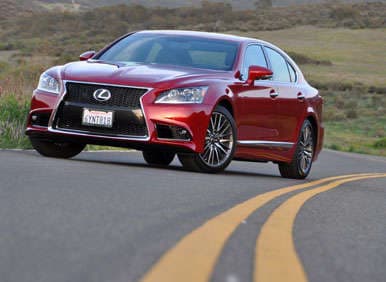
2013 Lexus LS Road Test and Review: Final Thoughts
The 2013 Lexus LS is a comfortable, quiet, and composed luxury sedan with many redeeming characteristics, and the F Sport variant is even fun to drive, something that cannot be said for any LS to come before it. However, the next-generation LS must make a defining design statement for the brand and it must contain bespoke interior materials and switchgear if it wants to continue as an A-list player against the Audi A8, BMW 7 Series, Jaguar XJ, Mercedes-Benz S-Class, and Porsche Panamera.
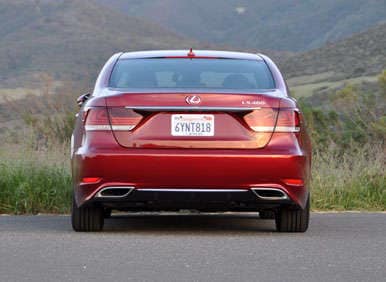
2013 Lexus LS Road Test and Review: Pros and Cons
- Quiet cabin
- Comfortable seats
- Gigantic trunk
- F Sport handling
- Styling updates
- Touchy brakes
- Evident cabin cost cutting
- F Sport needs more underhood oomph
- Getting surpassed on the technology front
Lexus supplied the vehicle for this review
2013 Lexus LS 460 F Sport photos by Christian Wardlaw
